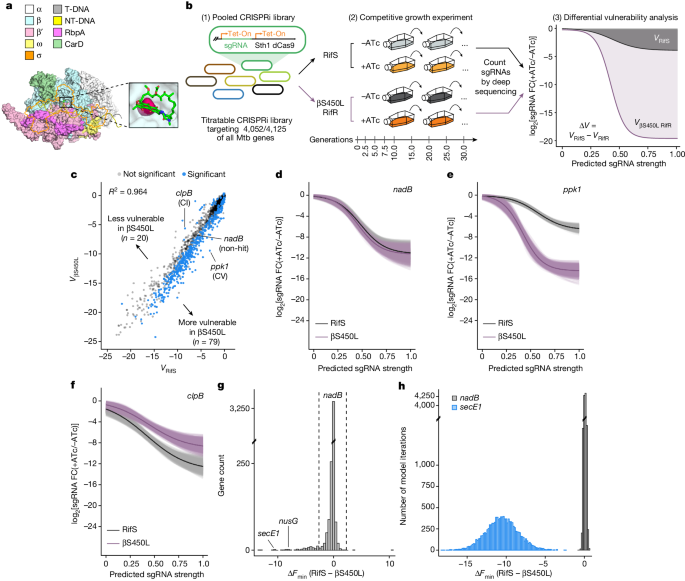Compensatory Evolution in NusG Enhances Fitness of Drug-Resistant M. tuberculosis
Kernkonzepte
Excessive RNAP pausing drives the fitness cost of Rifampicin resistance in M. tuberculosis, with compensatory evolution through NusG enhancing bacterial fitness.
Zusammenfassung
Drug-resistant bacteria pose a global threat despite being less fit than drug-susceptible strains. The study focuses on understanding the mechanisms that mitigate the fitness cost of rifampicin resistance (RifR) in Mycobacterium tuberculosis (Mtb). By employing a comparative genomics approach, researchers identified NusG as a crucial transcription factor for RifR Mtb fitness due to its pro-pausing function at the RNAP interface. Mutations affecting this interface reduce pausing activity and increase RifR Mtb's fitness, shedding light on potential therapeutic strategies to combat drug resistance evolution.
Compensatory evolution in NusG improves fitness of drug-resistant M. tuberculosis - Nature
Statistiken
Rifampicin-resistant Mtb accounts for one-quarter of deaths from drug-resistant bacteria.
NusG has an essential pro-pausing function in RifR Mtb.
Mutations in the NusG-RNAP interface reduce pro-pausing activity and increase RifR Mtb fitness.
Zitate
"We find this pro-pausing NusG–RNAP interface to be under positive selection in clinical RifR Mtb isolates."
"Collectively, these results define excessive RNAP pausing as a molecular mechanism that drives the fitness cost of RifR in Mtb."
Wichtige Erkenntnisse aus
by Kathryn A. E... um www.nature.com 03-20-2024
https://www.nature.com/articles/s41586-024-07206-5
Tiefere Fragen
How can the findings regarding compensatory evolution through NusG be applied to other drug-resistant bacterial pathogens
The findings on compensatory evolution through NusG in drug-resistant M. tuberculosis offer valuable insights that can be applied to other drug-resistant bacterial pathogens. By understanding how mutations in essential transcription factors like NusG can alleviate fitness costs associated with antibiotic resistance, researchers can explore similar mechanisms in different bacterial species. This approach could help identify common pathways or targets for compensatory evolution across various drug-resistant bacteria, potentially leading to the development of novel therapeutic strategies that exploit these shared mechanisms.
What are potential drawbacks or limitations of targeting excessive RNAP pausing as a therapeutic strategy against drug resistance
While targeting excessive RNAP pausing as a therapeutic strategy against drug resistance shows promise, there are potential drawbacks and limitations to consider. One limitation is the possibility of unintended consequences due to the complex regulatory networks involved in transcriptional processes. Modulating RNAP pausing may disrupt normal gene expression patterns, leading to unforeseen effects on bacterial physiology or virulence. Additionally, bacteria might develop alternative mechanisms to compensate for reduced RNAP pausing, rendering this approach less effective over time. Furthermore, specificity and off-target effects of drugs targeting RNAP pausing need careful consideration to avoid impacting host cells or beneficial microbiota.
How might understanding compensatory evolution at a molecular level impact broader evolutionary studies beyond antibiotic resistance
Understanding compensatory evolution at a molecular level not only sheds light on overcoming antibiotic resistance but also has implications for broader evolutionary studies. By dissecting the genetic and biochemical mechanisms underlying compensation for fitness costs associated with specific adaptations like antibiotic resistance, researchers can gain deeper insights into fundamental principles of adaptation and survival under selective pressures. This knowledge could extend beyond antimicrobial resistance scenarios and contribute to our understanding of evolutionary dynamics in diverse biological systems, including responses to environmental changes, host-pathogen interactions, and adaptation in natural populations.
0
